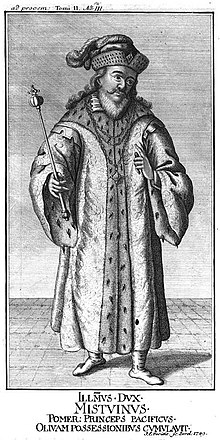Mestwin I.

Mestwin I. (Polish Mściwoj , Mszczuj ; * around 1160 ; † May 1, 1219 or 1220 ) was a duke in Pomerania from the Samborid dynasty . In the years 1210-1211 his domain was briefly under the sovereignty of the Danish royal family.
Life and political career
Mestwin I. was a son of Duke Sobiesław I († 1187) and a sister of the voivod Żyrosław of Kujawien from the Pował family , whose name has not been passed down. His predecessor was his brother Sambor I. In the Oliva tables , Mestwin has the nickname "pacificus" (the peacemaker). When the Pował family , of whom his mother was descended, died out around 1207 , he asserted his inheritance claims on the territory of the Wyszogród castellan (today Fordon ). He was married to Zwinisława († 1240), who was probably a daughter of Duke Mieszko of Poland or came from the local landed gentry. His rule fell during the time of Denmark's hegemony over the southern Baltic region . King Waldemar II subjugated Mecklenburg , Pomerania and, for a short time, the Duchy of the Samborids, Pomerania. The Free Cities of Lübeck and Hamburg had also recognized its protective sovereignty.
According to Johannes Voigt (1786–1863), Pomerania was already completely independent of Poland by this time. On the other hand, Mestwin had to swear the Danish king's feudal oath in 1210 when he had also taken Danzig on a campaign in Pruzzenland .
Probably on June 24, 1209, Mestwin I, “by the grace of God prince in Danzig”, “donated several places between the Radaune and its tributary Stolpe to a monastery for the nuns who serve God and St. Mary” . Since he had the consent of his four sons and his wife, the princess added the entire Oxhöfter Kämpe ( Kępa Oksywska ), the village of Bolschau in the Belgard castle district and the village of Grabowo near Schwetz as her share . The documents stipulate “voluntary and devotional, including all their jewelery”.
The monastery complex of the Zuckau monastery, built soon after 1209, is believed to be at the confluence of the Stolpe and the Radaune. The monastery in Zuckau was a Premonstratensian nunnery . It was not founded with the help of neighboring Pomeranian branches. That was prevented, perhaps by the Danish-Pomeranian fighting at that time. The mother monastery for Zuckau was rather the Sankt Vinzenzstift near Breslau , which had been occupied by Premonstratensians since 1180. Already in 1201 Pope Innocent III confirmed . St. Vinzenzstift, among other things, a Jacobi church in Zuckau. Tradition does not reveal how the connection between the Gdańsk princely family and the Wroclaw St. Vincent monastery came about. The establishment of a nunnery apparently met a need. A supply and educational facility for the daughters of the Princely House and the Pomeranian nobility was to be created. That was also the case in other countries.
Zuckau developed into a house monastery for female members of the Pomeranian princely house. Witosława, daughter of the founding couple and sister of Swantopolk II. And Sambor II., Is recorded as "magistra" (master) of this monastery in 1275 and 1289. In addition to a novice school , the monastery later also had a boys 'and a girls' school.
Mestwin I is also known that he appeared in a meeting of Polish great and high clergy in Mąkolin in 1212 as duke (dux), since he had broken away from Danish supremacy in 1211. Around 1213, on the occasion of a confirmation for the Zuckau monastery, he referred to himself again as "princeps" (in the sense of a governor). Mestwin died on May 1, 1219 or 1220.
Before his death, Mestwin I divided up his territory according to Slavic custom among his four sons. Swantopolk, the oldest, received the area around Danzig, Wartisław the southern part of the country with Schwetz and Mewe , Sambor received the residence Lubiszewo near Dirschau and Ratibor the western part with the headquarters in Belgard. Wartisław died in Schwetz around 1229, the brothers divided his territory. Swantopolk gained supremacy over all of Pomerania through the possession of Danzig and the castles Sartowitz , Zantir and Schwetz on the bank of the Vistula .
Marriage and offspring
Mestwin had four sons and five daughters from his marriage to Zwinisława:
- Swantopolk II. (Approx. 1195–1266), governor, from 1227 Duke of Pomerania in Danzig
- Wartisław I (approx. 1195–1227 / 1233), Duke of Pomerania in Schwetz and Mewe
- Sambor II. (Approx. 1211 / 12–1276 / 1278), governor, from 1227 Duke of Pommerellen in Liebschau and Dirschau
- Ratibor (approx. 1212–1272), Duke of Pomerania in Belgard
- Miroslawa (approx. 1190–1233 / 1240), as the wife of Duke Bogislaw III. by marriage to the Duchess of Pomerania
- Jadwiga (approx. 1200–1249), as the wife of Duke Władysław Odonic by marriage to the Duchess of Greater Poland
- Witosława (approx. 1205–1290), prioress of the Zuckau monastery
- NN (? -?), Nun in the monastery of Zuckau
- NN (? -?), Nun in the monastery of Zuckau
literature
- Theodor Hirsch , Max Töppen, Ernst Gottfried Wilhelm Strehlke: Scriptores rerum Prussicarum : The historical sources of Prussian prehistoric times
- Max Perlbach : Mestwin I. In: General German Biography (ADB). Volume 21, Duncker & Humblot, Leipzig 1885, p. 503 f.
Web links
- Mestwin I. Prince of Pommerellen on portal: genealogie-mittelalter.de
Footnotes
- ↑ Johannes Voigt: History of Prussia from the oldest times to the fall of the rule of the Teutonic Order . Volume One: The Age of Paganism . Königsberg 1827, p. 370.
| personal data | |
|---|---|
| SURNAME | Mestwin I. |
| ALTERNATIVE NAMES | Mściwoj; Mszczuj |
| BRIEF DESCRIPTION | Duke of Pomeranian |
| DATE OF BIRTH | around 1160 |
| DATE OF DEATH | May 1, 1219 or 1220 |

